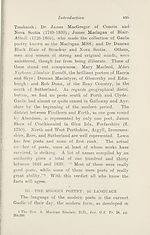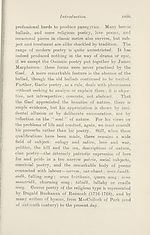Download files
Complete book:
Individual page:
Thumbnail gallery: Grid view | List view

xxii. Introduction
Scotland, of the ancient language which fox- so many
centuries was common to Scotland and Ireland. In
their use of the vernacular, they broke away, as did
the modern Irish poets, from the literary dialect of the
classical school, which contained many words and ex¬
pressions already obsolete in common speech. This
literary language was, of course, familiar to the trained
professional bards—it formed part of their education—
and it was also understood by the ruling families, to
whom so much of the poetry composed therein was
addressed, but it could not have been very intelligible
to the people generally. We possess, for instance,
three elegies on Sir Norman Macleod of Bernera (d.
1705), two of them in the classic style, the third in the
vernacular. To anyone who knows Scottish Gaelic,
this last presents no special difficulty to-day.: the others
demand a very competent knowledge of the old style.1
In short, the classic poetry was addressed to the
aristocracy of birth and of learning; the modern poetry
is addressed to the people.
IV.—THE MODERN POETRY: (6) CONTENT
In its content, the new poetry shows a great advance
on the classic school in range and in variety. It was
the chief business, as it was also the interest, of the
1 The opening quatrain of the longer of the classic elegies is : —
Do thurn aoibhneas Innse Gall,
damhna dobroin da thadhal:
othar is amhghar gan cheilt
an dochar adhbhal oirdheirc.
“ Gone is the joy of Innse Gall (the Isles), a cause of woe is haunt¬
ing it; sickness and affliction without hiding is the great conspicu¬
ous injury.” There are here five obsolete words, and one,
oirdheirc, used in a sense now obsolete in Scottish Gaelic.
Scotland, of the ancient language which fox- so many
centuries was common to Scotland and Ireland. In
their use of the vernacular, they broke away, as did
the modern Irish poets, from the literary dialect of the
classical school, which contained many words and ex¬
pressions already obsolete in common speech. This
literary language was, of course, familiar to the trained
professional bards—it formed part of their education—
and it was also understood by the ruling families, to
whom so much of the poetry composed therein was
addressed, but it could not have been very intelligible
to the people generally. We possess, for instance,
three elegies on Sir Norman Macleod of Bernera (d.
1705), two of them in the classic style, the third in the
vernacular. To anyone who knows Scottish Gaelic,
this last presents no special difficulty to-day.: the others
demand a very competent knowledge of the old style.1
In short, the classic poetry was addressed to the
aristocracy of birth and of learning; the modern poetry
is addressed to the people.
IV.—THE MODERN POETRY: (6) CONTENT
In its content, the new poetry shows a great advance
on the classic school in range and in variety. It was
the chief business, as it was also the interest, of the
1 The opening quatrain of the longer of the classic elegies is : —
Do thurn aoibhneas Innse Gall,
damhna dobroin da thadhal:
othar is amhghar gan cheilt
an dochar adhbhal oirdheirc.
“ Gone is the joy of Innse Gall (the Isles), a cause of woe is haunt¬
ing it; sickness and affliction without hiding is the great conspicu¬
ous injury.” There are here five obsolete words, and one,
oirdheirc, used in a sense now obsolete in Scottish Gaelic.
Set display mode to:
![]() Universal Viewer |
Universal Viewer | ![]() Mirador |
Large image | Transcription
Mirador |
Large image | Transcription
| An Comunn Gàidhealach > An Comunn Gàidhealach Publications > Bàrdachd Ghàidhlig > (26) |
|---|
| Permanent URL | https://digital.nls.uk/126455330 |
|---|
| Description | This contains items published by An Comunn, which are not specifically Mòd-related. It includes journals, annual reports and corporate documents, policy statements, educational resources and published plays and literature. It is arranged alphabetically by title. |
|---|
| Description | A collection of over 400 items published by An Comunn Gàidhealach, the organisation which promotes Gaelic language and culture and organises the Royal National Mòd. Dating from 1891 up to the present day, the collection includes journals and newspapers, annual reports, educational materials, national Mòd programmes, published Mòd literature and music. |
|---|---|
| Additional NLS resources: |
|

